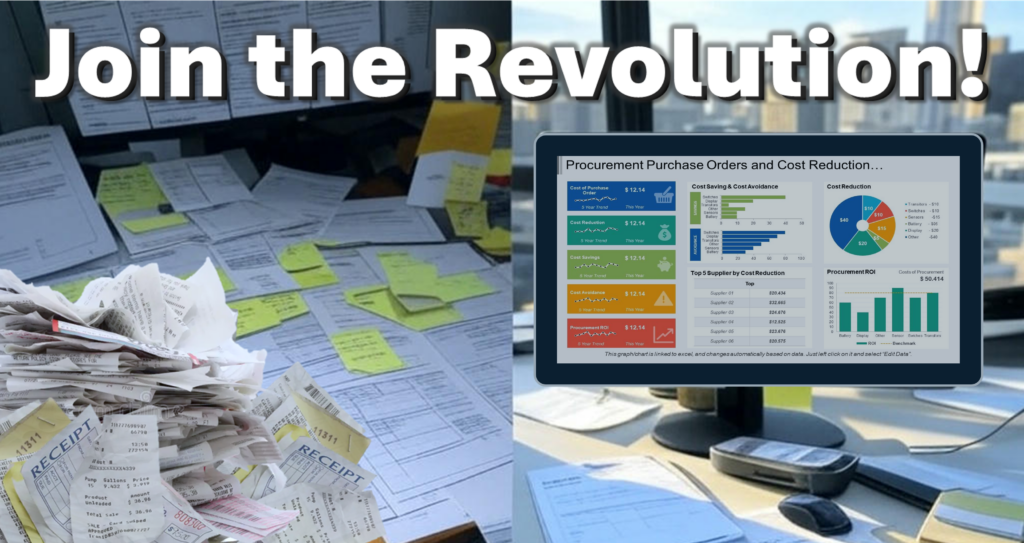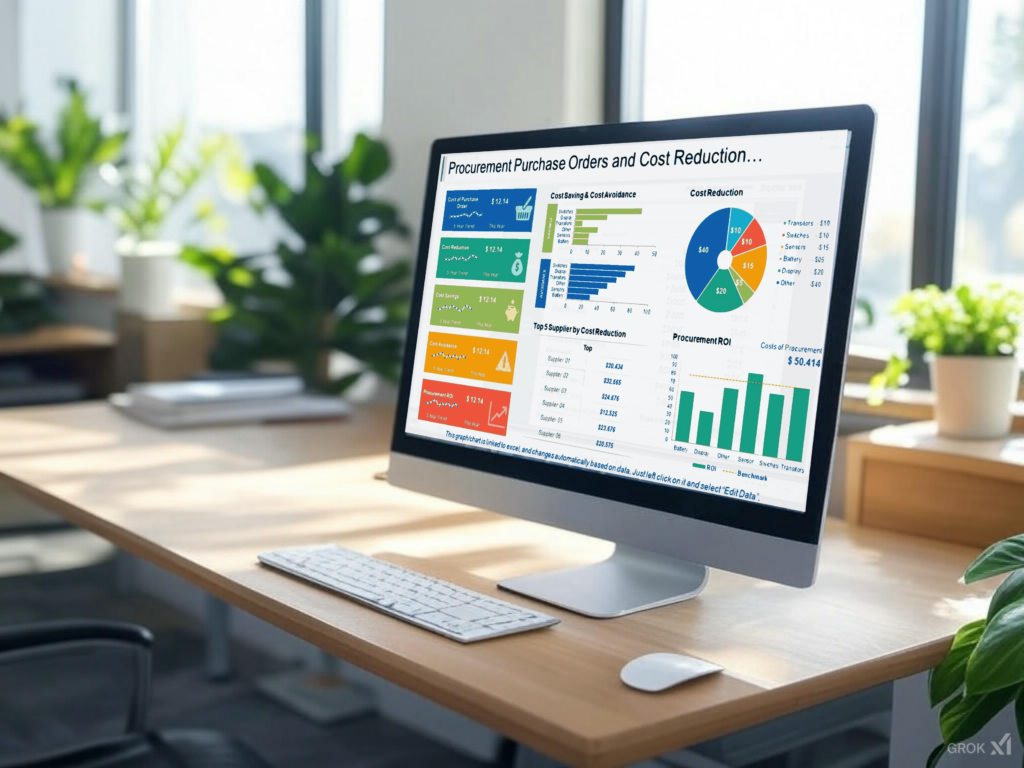
Alright, folks, let’s talk rebates. You know, those lovely little discounts that should be putting smiles on everyone’s faces but instead often cause headaches and paperwork avalanches?
One of our clients, a large national landscaping service provider, knew this pain all too well. Before we swooped in, they were stuck in the dark ages of rebate management. Imagine a world where critical purchasing information was delayed by months.
Yes, you read that right. Six to eight weeks (or sometimes more than TWO MONTHS) of lag time. In today’s fast-paced business environment, that’s practically ancient history. It was so manual. You can only imagine the papercuts…
Consider the enormity of managing a large, dispersed fleet of local providers for a national landscaping company. Think of it, supplies and field equipment for tens of thousands of employees, including their trucks, trailers and all the tools, fuels, fertilizers and consumables associated with dealing with various climates and creating or maintaining beautiful interior and exterior landscapes of every description, from theme parks to corporate campuses.
The Dark Days of Manual Rebates
Now, picture trying to handle rebate management and corporate purchasing for this complex structure using nothing but spreadsheets. That was the reality for one of the largest managed landscaping providers in the country until they partnered with Rahsegel Solutions.

Before Rahsegel, this customer’s rebate process looked something like this:
- A chaotic mess of constantly outdated spreadsheets.
- Lagging data that made the best decisions impossible.
- Information silos where nobody could see the big picture. People only saw their “little slice of the pie,” with no comprehensive view.
Basically, they were flying blind, just throwing money at things and hoping for the best. As you can imagine, this is not a recipe for success. It was like trying to assemble Ikea furniture with no instructions and a rubber mallet; messy, ineffective, and likely to result in tears.
The company juggled hundreds of rebate programs with “preferred” suppliers, covering everything from plumbing and fertilizers to tires and tools—pretty much the whole landscaping shebang.
- Programs came in flavors like “flat,” “tiered,” or “market share”—thought of as “spent more, got more” or “spent less, got less.” A fan favorite was the tiered rebates: spend X, snag Y%; spend Z, settle for Y-2%.
- Rebates were tracked the old-fashioned way—digitally! (albeit the wrong kind of digital – Excel files mashed into a PowerBI dashboard.) It was slow, intensely manual, messy, and a magnet for mistakes.
- Data came from a chaotic mix of sources, crunched into monthly reports:
- Vendor reports straight from suppliers. (“Mr. Fox, kind sir, can you please tell me about my chickens?”)
- Credit card data, blending internal numbers with the bank’s rear-view mirror take.
- Consolidated “ReportsNow-n-Later”, pulling from the internal ERP AP.
Problems? Oh, they were everywhere...
Vendor Reports – Vendors sent monthly reports on rebate-eligible spend (no tax, freight, or negotiated-out projects):
- These were the simplest, most accurate way to track—straight from the horse’s, er, fox’s mouth.
- The downside was vendors botched location numbers, sending rebates to the wrong crew.
- Worse, internal systems couldn’t double-check, so sneaky vendors might have lowballed spend to skimp on rebates.
Credit Card Reporting – Driving forward by looking in the rear-view mirror:
- The bank spit out total credit card rebate numbers, but no branch or division breakdown.
- Concur (Pcard spend) and ReportsNow (ghost card spend) tried to fill the gaps—slow, sloppy, and never matched the bank’s totals.
3rd Party Reporting – Last month’s spend, next month!
- For vendors too small (or lazy?) to report monthly, they manually slogged—scrubbed tax and fees by hand, leaving plenty of room for oopsies.
- Excluded projects? Branch-level secrets the procurement team never heard about.
- Bonus: It flagged past-due vendor invoices too. Yay!
MR. T. – You had to pity da fool that relied on the Master Rebates Tracker spreadsheet…
- All this mess fed the Master Rebate Tracker (MRT)—a companywide snapshot of rebates earned and projected, ignoring branch or division details.
- Projections were calculated with current spend plus last year’s patterns.
- Say they spent $10 monthly last year (8.33% a month).
- By March (25% of the year), they’d spent $60 that year.
- Multiply that by 4, and boom—$240 projected. (Real life was messier, but you get it.)
- Branch & Division Tracking
- A monster spreadsheet combined everything, showing how branches stacked up against budgets.
- It fueled the PowerBI dashboard for monthly(ish) progress checks—manual, massive, and a breeding ground for errors.
It was better than nothing, but still a hot mess.
Rahsegel to the Rescue
Enter Rahsegel Solutions, the caped crusaders of corporate Efficiency2.0™! We didn’t just sprinkle some fairy dust; we implemented a state-of-the-art rebate system that dragged our client kicking and screaming into the 21st century.

Here’s how we turned their rebate nightmare into a dream come true:
- Real-Time Visibility: Say goodbye to those agonizing delays. With our system, they finally had access to real-time information. Imagine that, knowing where your money is going as it’s going there.
- A Holistic View: No more little slices of the pie. The customer could now see exactly where their money was going. They could identify critical vendors, optimize spending, and finally understand the full scope of their rebate programs.
- Accountability: Remember those days when nobody knew who was responsible for what? Gone. Our system brought accountability to the forefront, empowering locations to manage their spending like the pros they are.
- Business Intelligence (BI) Reporting: Knowledge is power, people. Our system included robust BI reporting, giving corporate and branch managers the insights they needed to make strategic decisions in the field – on a Sunday night – at 3am, if needed. Can your operators do that?
- Resource Diversity & Diversion: Identify critical vendors. See where resources are best allocated. Negotiate the best deals.
- Centralized Claims Management: It helps to track, validate, and process claims efficiently, reducing administrative overhead. This is crucial for corporations dealing with large volumes of claims.
The Moral of the Story
The transformation for our customer proves the right technology can turn rebate management from a liability into an asset.
If you’re tired of manual processes, lagging data, and general rebate-related misery, maybe it’s time to give Rahsegel Solutions a call!



